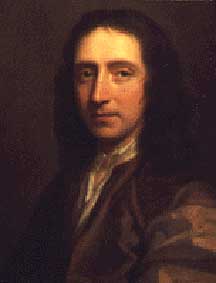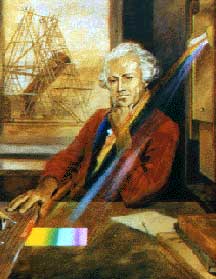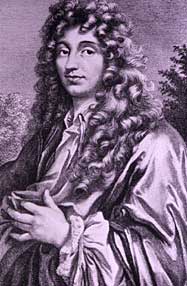ASTRONOMERS
AGE OF ENLIGHTENMENT
 GIOVANNI CASSINI (1625 A.D. - 1712 A.D.)
GIOVANNI CASSINI (1625 A.D. - 1712 A.D.)
Giovanni Cassini was an Italian-French astronomer. In 1650 at the age of 25, he became a professor of astronomy at the University of Bologna. While there, he kept detailed observations of a comet from 1652-53 and again from 1664-65. He also published his findings. In 1669, he was invited to Paris by King Louis XIV, where he later became the director of the Paris Observatory in 1671. Two years later, he became a citizen of France.
Cassini was the first to observe Saturn's four moons. He also discovered a gap in the ring system of Saturn, which is now known as the Cassini division. Additionally, he calculated the deformation of Jupiter and its rotation time, watched the phases of Venus and clarified the visible surface marks of Mars. In 1672, he discovered Rhea, which is another one of Saturn's moons.
 EDMOND HALLEY (1656 A.D. - 1742 A.D.)
EDMOND HALLEY (1656 A.D. - 1742 A.D.)
Edmond Halley was an English astronomer who discovered the proper motion of stars and the periodicity of comets. He was a key figure in the English scientific community at the height of its creativity. As an undergraduate student, he seriously began observing and published a paper on theoretical astronomy. He is primarily known for "A Synopsis of the Astronomy of Comets," published in 1705, but also made other significant contributions.
From 1676 - 78, Halley catalogued the positions of 350 Southern Hemisphere stars and observed a transit of Mercury. He was convinced that by studying transits of Mercury, as well as future transits of Venus, they could be used to determine the distance of the sun. He worked out a theory of cometary orbits and concluded that the comet of 1682, which still bears his name, was periodic. Additionally, he correctly predicted that this comet would return again in 76 years.
 SIR WILLIAM HERSCHEL (1738 A.D. - 1822 A.D.)
SIR WILLIAM HERSCHEL (1738 A.D. - 1822 A.D.)
Herschel was an English astronomer, whose love of astronomy was given to him by his father. He built high magnification telescopes that let him observe the heavens with great detail. In March 1781 while he was working on an extension of his double star catalogue, he observed a bright object in an area near the star H Geminorum, where the charts showed no star at all. He thought that this might be a comet. Upon further observations and discussion with other prominent astronomers, it was determined that he discovered the planet Uranus.
In November of 1781, he was invited to London by the Royal Society and presented with the Copley medal. Later on that year, he was elected a Fellow of the Royal Society. In May of 1782, he traveled to London by invitation from King George III. During this time, he was offered the position of court astronomer at Windsor. Herschel named his new planet "Georgium sidus" (George's star) after the king. The name was changed later to Uranus by fellow astronomers, although Herschel always referred to the planet as Georgium sidus. In 1784 he started to build telescopes to sell. Some of his customers included the King of Spain, the Prince of Canino, the Russian court and the Austrian Emperor.
Between 1786 and 1802, Herschel helped advance our understanding of nebulae, the hazy clouds that surround dying stars, by publishing three catalogues containing data on 2,500 nebular objects. These observations were done with a 20-foot telescope. In 1786 Herschel started to build a 40-foot telescope that underwent considerable reconstruction before it met with his approval. The telescope became fully functional in August of 1789, and Herschel observed Saturn with it where he discovered the sixth moon (Enceladus) of Saturn. A month later he found Mimas, the seventh satellite of Saturn.
 CHRISTIAN HUYGENS (1629 A.D. - 1695 A.D.)
CHRISTIAN HUYGENS (1629 A.D. - 1695 A.D.)
Christian Huygens was born in The Hague in 1629. He was a Dutch physicist and astronomer. In 1654 with the help of his brother, he devised an improved method for grinding and polishing lenses, making telescopes more powerful. As a result, Huygens first identified Saturn's rings and one of Saturn's moons.
His astronomical findings necessitated exact means of measuring time, which led to the invention of the pendulum clock in 1656. Around 1681 he devoted himself to the construction of lenses of tremendous focal length. Around this time he discovered the achromatic eye-piece of a telescope. After his death, one of his works was printed which further proved how the magnifying power of a telescope could be determined by the focal lengths of the component lenses.
 SIR ISAAC NEWTON (1643 A.D. - 1727 A.D.)
SIR ISAAC NEWTON (1643 A.D. - 1727 A.D.)
Sir Isaac Newton was perhaps the greatest scientific genius of all time, making fundamental contributions to every major area of science in his generation. In 1684, Newton was visited by Edmond Halley, who discussed with him the problem of orbital motion. This renewed an interest in Newton that he had had as an undergraduate about the basic concepts of universal gravitation. As a result of these discussions with Halley, he returned to these studies. His finest accomplishment was his work in physics and celestial mechanics, which resulted in his theory of universal gravitation along with the three laws of motion. He applied his laws to Kepler's laws of orbital motion and determined the law of universal gravitation. Given the law of gravitation and the laws of motion, Newton explained a myriad of phenomena, such as the orbits of comets, the causes of the tides, the precession of the Earth's axis, as well as the motion of the moon by the gravity of the sun.
Newton is credited with writing the greatest scientific book in 1687 universally known as the Principia. In 1708, he was knighted by Queen Anne, the first scientist to be honored for his work.